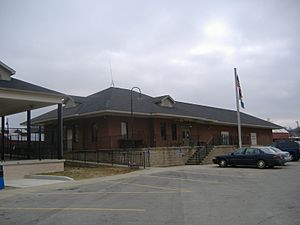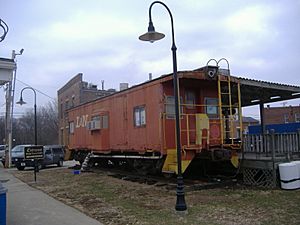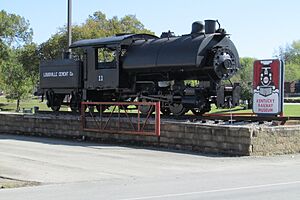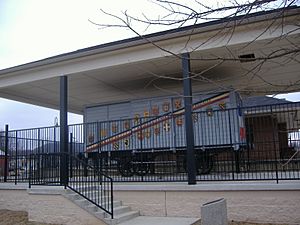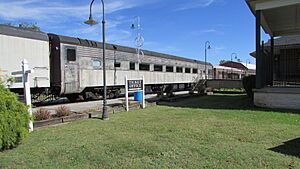Kentucky Railway Museum facts for kids
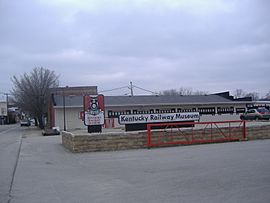
Entrance to the museum facility
|
|
| Lua error in Module:Location_map at line 420: attempt to index field 'wikibase' (a nil value). | |
| Established | 1954 |
|---|---|
| Location | New Haven, Kentucky, United States |
| Type | Railroad |
The Kentucky Railway Museum is a special place in New Haven, Kentucky. It's a museum all about trains and the history of railroads in Kentucky. This museum helps people learn about the amazing trains and the people who built them.
The museum started way back in 1954 in Louisville, Kentucky. It has moved a couple of times and is now in its third home in southern Nelson County. It's one of the oldest railroad museums in the United States!
The museum has a big collection of trains. It owns four steam locomotives, twelve diesel locomotives, and more than one hundred other train cars. Some of these trains are so important that they are listed on the National Register of Historic Places. These include the Louisville and Nashville Steam Locomotive No. 152, the Louisville and Nashville Combine Car Number 665, the Mt. Broderick Pullman Lounge-Obs-Sleeping Car, and the Frankfort and Cincinnati Model 55 Rail Car.
Contents
A Look at the Museum's History
The land where the museum is now was first used by the Louisville and Nashville Railroad between 1856 and 1857. This was for their old train line that went to Lebanon, Kentucky. During the 1860s, this train line was very important for the Union side in the Civil War. Because of this, it was often attacked by Confederate forces, like those led by John Hunt Morgan. A nearby bridge was even destroyed! The train station you see at the museum today is a new version, built in the 1990s, that looks like the one from 1910.
The museum was officially started in 1954 by train fans from Louisville. They wanted to save old steam locomotives and other train items. One of the first trains they showed was the Louisville and Nashville #152 locomotive, along with a caboose and a wooden coach. These first donations, including train tracks, came from the Monon Railroad and the Louisville and Nashville Railroad.
The museum has moved twice since it began. Its first home was in Louisville, at 1837 East River Road. This spot is now where the Louisville Soccer Fields are. That first location was about 6 acres big and was fenced and lit by the Louisville Parks Department. The museum opened to the public there on May 30, 1958. They eventually left this spot because of floods from the nearby Ohio River and because they needed more space. A very bad flood happened in March 1964.
In December 1975, the museum decided to move to a bigger and safer place. In 1977, it moved to the Ormsby Village area in Louisville. This new spot was called Ormsby Station and was about 32 acres. However, the county told the museum that they could not stay after 1993. The land was becoming very valuable for businesses.

Because they had to move again, the museum came to its current home in New Haven. It opened there on July 4, 1990. The first part of the New Haven site was 8 acres with a building. It was given to the museum by Lewis and Chester Simms, who were businessmen from New Haven, and their wives. The museum uses the last eighteen miles of the old Louisville and Nashville Railroad line. This line was then controlled by CSX Transportation, which had taken over the Louisville and Nashville Railroad in the 1970s. Train rides for visitors started at the New Haven site in May 1991. The move also helped the New Sherwood Hotel get a new look.
Many people helped raise money to move the museum from Louisville to New Haven. Glenn Rutherford, a reporter for the Louisville Courier-Journal, was a big help. He wrote many stories about the museum's trains to encourage donations. He was honored in November 2003 for all his hard work.
The Kentucky Railway Museum had some problems with vandalism in its new location. In June 1992, they had to build a special fence after three young people damaged some of the historic train cars. The museum director at the time, Rich Collins, worried that the museum might look like a prison.
In 1999, the Kentucky Railway Museum received money from CSX Transportation to create a traveling exhibit.
There is another historic train ride in Nelson County called My Old Kentucky Dinner Train. It starts at the Old Louisville and Nashville Station in Bardstown, Kentucky.
What You Can See and Do
One of the most famous steam locomotives at the museum is Louisville and Nashville Railroad #152. This train is a 4-6-2 Pacific style, and it's believed to be the last working steam locomotive from the L&N railroad. The museum runs a special train line and offers fun train rides on certain weekends in the summer and fall. The train travels on a part of the L&N's old main line, from Boston to New Haven. At New Haven, there's also a big model train display and a gift shop. These are in a brick building that looks like the old L&N train station.
Museum Locomotives
The Kentucky Railway Museum has a great collection of trains. They own 4 steam locomotives and 12 diesel locomotives. Some of these are being fixed up, and others are ready to run! You can see a full list of them below.
| Image | Locomotive | Manufacturer | Build Date | Wheel Arrangement | Status | Notes |
|---|---|---|---|---|---|---|
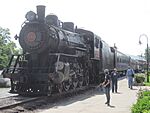 |
Louisville & Nashville #152 | Rogers Locomotive Works | 1905 | 4-6-2 "Pacific"
Class: K-2A |
Restoration | This is the official state steam locomotive of Kentucky. It's on the National Register of Historic Places. It has been out of service since 2011 and is currently being inspected. |
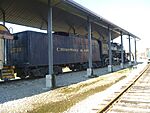 |
Chesapeake & Ohio #2716 | Alco Locomotive Works | 1943 | 2-8-4 "Berkshire"
Class: K-4 |
Restoration | This train is on a long-term lease to the Kentucky Steam Heritage Corporation in Ravenna, KY. |
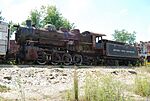 |
Louisville & Nashville #2152 | Alco Locomotive Works | 1925 | 0-8-0 "Switcher"
Class: USRA |
Display | This train was recently fixed up to look like its original L&N colors and is now on display. |
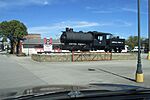 |
Louisville Cement Company #11 | Vulcan Iron Works (Wilkes-Barre) | 1923 | 0-4-0TT "Switcher" | Display | This train was fixed up over the past few years. It is now displayed at the museum entrance. It has a special narrow gauge of 39 and a half inches. |
| Image | Locomotive | Manufacturer | Build Date | Model | Status | Notes |
|---|---|---|---|---|---|---|
 |
Louisville & Nashville #411 | Electro-Motive Diesel | 1953 | GP-7 | Operational | This train was first built as Reading #615. It was repainted to look like a basic black L&N freight train. |
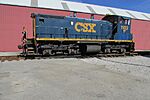 |
CSX (Louisville & Nashville) #1103 | Electro-Motive Diesel | 1970 | SW-1500 | Operational | CSX donated this train in 2019. It will eventually be painted back into L&N colors. |
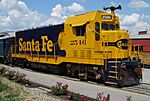 |
Santa Fe #2546 | Electro-Motive Diesel | 1949
Rebuilt 1973 |
CF-7 | Operational | This train was originally built as F-7 #229L. It was later rebuilt into a CF-7. |
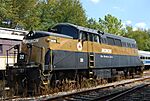 |
Monon #32 | Electro-Motive Diesel | 1948 | BL-2 | Operational | This train runs on special occasions. |
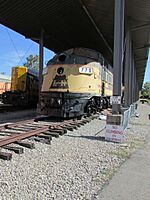 |
Louisville & Nashville #770 | Electro-Motive Diesel | 1942 | E6A | Cosmetic Restoration | This is an empty shell that is currently being fixed up to look nice. |
| Frankfort & Cincinnati | Brill Company | 1927 | Model
55-1 |
Stored | This train is stored in a shed. | |
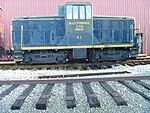 |
Baltimore & Ohio #21 | General Electric | 1943 | 44-Ton Switcher | Operational | This train was built as USAF #1223. |
| Kentucky Utilities #1 | General Electric | 1956 | 45-Ton Switcher | Operational | This train was recently painted back to its original KU colors. | |
| Louisville Gas & Electric (LG&E) #1 | General Electric | ? | 110-Ton Switcher | Stored | This train was given to the museum just months before a fire destroyed its original plant. | |
| Indiana Ammunition Plant #1038 | Plymouth Locomotive Works | 1940's | - | Operational | ||
| Indiana Ammunition Plant #???? | Plymouth Locomotive Works | 1940's | - | Display | ||
| Indiana Ammunition Plant #1032 | Plymouth Locomotive Works | 1940's | - | Operational; privately owned |
Famous Locomotives at the Museum
The old Louisville and Nashville Steam Locomotive #152 is one of the trains that takes passengers on trips to Boston, Kentucky. The president of the Louisville and Nashville Railroad, William H. Kendall, gave it to the museum in 1957. It is the oldest known 4-6-2 Pacific type train still around. It was even named the "Official State Locomotive of Kentucky" on March 6, 2000.
Another important train from the museum's early days is the Monon Route's Diesel Engine No. 32. This train was painted black and gold by Monon to match the school colors of Purdue University. Monon bought it in 1948. Then, the Louisville and Nashville Railroad got it in August 1971. It became a display at the museum in 1972.
The Chesapeake and Ohio 2716 train used to be on display at the museum. It is now in Ravenna, Kentucky, where it is being fixed up to run again. This train was first given to the museum in 1959. It has been restored to run by other groups four times! For example, in 1980, the Southern company used it for their steam train program. In 2019, the Kentucky Steam Heritage Corp leased it and moved it to Ravenna, KY to restore it. They are still working on it as of 2025.
Special Train Cars
The museum also has several historic train cars.
The Louisville and Nashville Combine Car Number 665 was a very rare train car. It was one of only two "two wood side steel" cars ever made. It was designed during the time of the Jim Crow laws. This meant that white passengers sat at the front of the car, and black passengers sat at the back. The Louisville and Nashville Railroad gave this car to the museum in 1958. In the 1960s, during the Civil War Centennial, this car was pulled by the famous Civil War-era steam locomotive The General. It traveled to many places in the Eastern U.S.
The Mt. Broderick Pullman Car was like a fancy hotel on wheels! It had shiny brass in the bathrooms and beds that pulled out. The Pullman Company sold this car to the museum in 1958.
Another historic car at the museum that is on the National Register is the Frankfort and Cincinnati Model 55 Rail Car. It was also known as The Cardinal because of its red color. This train car runs on gas and used to travel on the Frankfort and Cincinnati Railroad's "Whiskey Route" between Frankfort, Kentucky and Paris, Kentucky.
Fun Train Rides
You can take train rides that leave regularly from the museum. The trains go to Boston, Kentucky, and then come back. Along the way, you can see beautiful views of the Rolling Fork River Valley. The train crosses roads fourteen times on just one trip! The whole ride is about 22 miles long and takes about one hour.
Sometimes, the museum has special train rides with fun themes. These can include train robberies, haunted trains, and visits from the Easter Bunny, Santa Claus, or even Thomas the Tank Engine.
Inside Exhibits
One of the buildings at the museum has an amazing model train display. These model trains are set up in glass-covered scenes called dioramas. The display covers a huge area of 3000 square feet! Some of the scenes include a German landscape with a village and a carnival. Another scene shows workers laying down train tracks.
See also
- List of attractions and events in the Louisville metropolitan area
- List of heritage railroads in the United States


